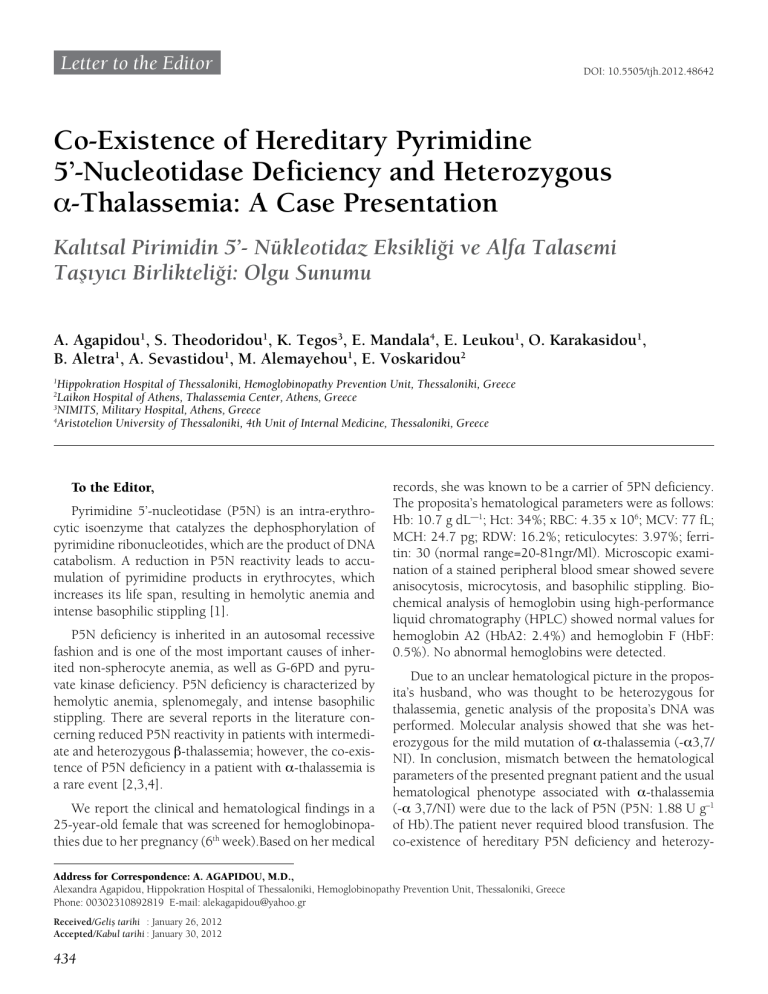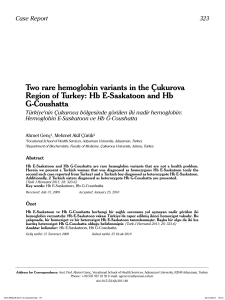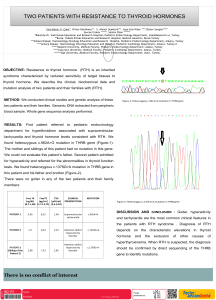
Letter to the Editor
DOI: 10.5505/tjh.2012.48642
Co-Existence of Hereditary Pyrimidine
5’-Nucleotidase Deficiency and Heterozygous
α-Thalassemia: A Case Presentation
Kalıtsal Pirimidin 5’- Nükleotidaz Eksikliği ve Alfa Talasemi
Taşıyıcı Birlikteliği: Olgu Sunumu
A. Agapidou1, S. Theodoridou1, K. Tegos3, E. Mandala4, E. Leukou1, O. Karakasidou1,
B. Aletra1, A. Sevastidou1, M. Alemayehou1, E. Voskaridou2
Hippokration Hospital of Thessaloniki, Hemoglobinopathy Prevention Unit, Thessaloniki, Greece
Laikon Hospital of Athens, Thalassemia Center, Athens, Greece
3
NIMITS, Military Hospital, Athens, Greece
4
Aristotelion University of Thessaloniki, 4th Unit of Internal Medicine, Thessaloniki, Greece
1
2
To the Editor,
Pyrimidine 5’-nucleotidase (P5N) is an intra-erythrocytic isoenzyme that catalyzes the dephosphorylation of
pyrimidine ribonucleotides, which are the product of DNA
catabolism. A reduction in P5N reactivity leads to accumulation of pyrimidine products in erythrocytes, which
increases its life span, resulting in hemolytic anemia and
intense basophilic stippling [1].
P5N deficiency is inherited in an autosomal recessive
fashion and is one of the most important causes of inherited non-spherocyte anemia, as well as G-6PD and pyruvate kinase deficiency. P5N deficiency is characterized by
hemolytic anemia, splenomegaly, and intense basophilic
stippling. There are several reports in the literature concerning reduced P5N reactivity in patients with intermediate and heterozygous β-thalassemia; however, the co-existence of P5N deficiency in a patient with α-thalassemia is
a rare event [2,3,4].
We report the clinical and hematological findings in a
25-year-old female that was screened for hemoglobinopathies due to her pregnancy (6th week).Based on her medical
records, she was known to be a carrier of 5PN deficiency.
The proposita’s hematological parameters were as follows:
Hb: 10.7 g dL—1; Hct: 34%; RBC: 4.35 x 106; MCV: 77 fL;
MCH: 24.7 pg; RDW: 16.2%; reticulocytes: 3.97%; ferritin: 30 (normal range=20-81ngr/Ml). Microscopic examination of a stained peripheral blood smear showed severe
anisocytosis, microcytosis, and basophilic stippling. Biochemical analysis of hemoglobin using high-performance
liquid chromatography (HPLC) showed normal values for
hemoglobin A2 (HbA2: 2.4%) and hemoglobin F (HbF:
0.5%). No abnormal hemoglobins were detected.
Due to an unclear hematological picture in the proposita’s husband, who was thought to be heterozygous for
thalassemia, genetic analysis of the proposita’s DNA was
performed. Molecular analysis showed that she was heterozygous for the mild mutation of α-thalassemia (-α3,7/
NI). In conclusion, mismatch between the hematological
parameters of the presented pregnant patient and the usual
hematological phenotype associated with α-thalassemia
(-α 3,7/NI) were due to the lack of P5N (P5N: 1.88 U g–1
of Hb).The patient never required blood transfusion. The
co-existence of hereditary P5N deficiency and heterozy-
Address for Correspondence: A. AGAPIDOU, M.D.,
Alexandra Agapidou, Hippokration Hospital of Thessaloniki, Hemoglobinopathy Prevention Unit, Thessaloniki, Greece
Phone: 00302310892819 E-mail: [email protected]
Received/Geliş tarihi : January 26, 2012
Accepted/Kabul tarihi: January 30, 2012
434
Turk J Hematol 2012; 29: 434-435
gous α-thalassemia is extremely interesting due to the fact
that to the best of our knowledge this is the first report of
such a case.
Conflict of Interest Statement
The authors have no conflicts of interest, including
specific financial interests, relationships, and/or affiliations, relevant to the subject matter or materials presented.
Agapidou A, et al: Pyrimidine 5’-Nucleotidase and α-Thalassemia
References
1. Evdokia Mandala, Study of Pyrimidine 5- Nucleotide(P5N)
Activity In Hereditary Hemoglobinopathies. DoctorateThesis, Thessaloniki 1997.
2. Zerez CR, Lachant NA, Lent KM, Tanaka KR. Decreased
pyrimidine nucleoside monophosphate kinase activity in
sickle erythrocytes. Blood 1992; 80:512-516.
3. David O, Sacchetti L, Vota MG, Comino L, Perugini L,
Pescarmona GP. Pyrimidine 5’-nucleotidase and oxidative
damage in red blood cells transfused to beta-thalassemic
children. Haematologica 1990; 75:313-318.
4. Dell’Edera D, Malvasi A, Tinelli A, Mazzone E, Leo M, Monti
V, Epifania AA. Importance of the molecular diagnosis in
the screening of alpha-thalassemia. Recenti Prog Med 2011;
102(7-8):302-306. doi: 10.1701/913.10050. Italian.
435





